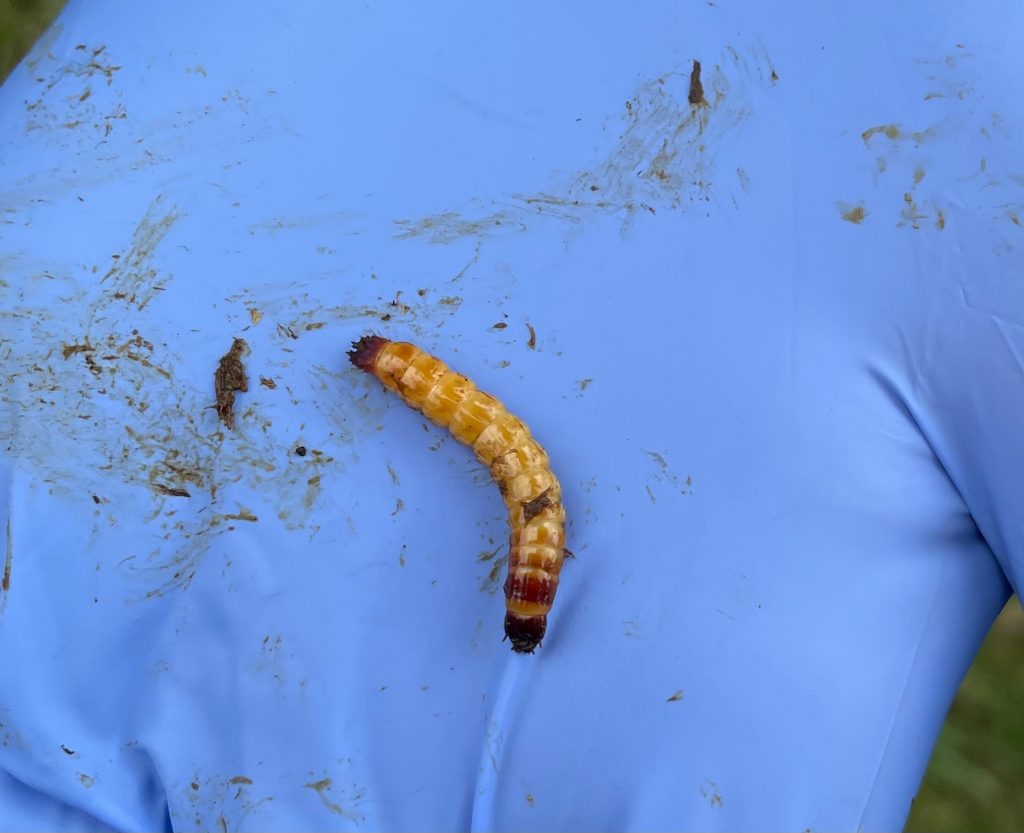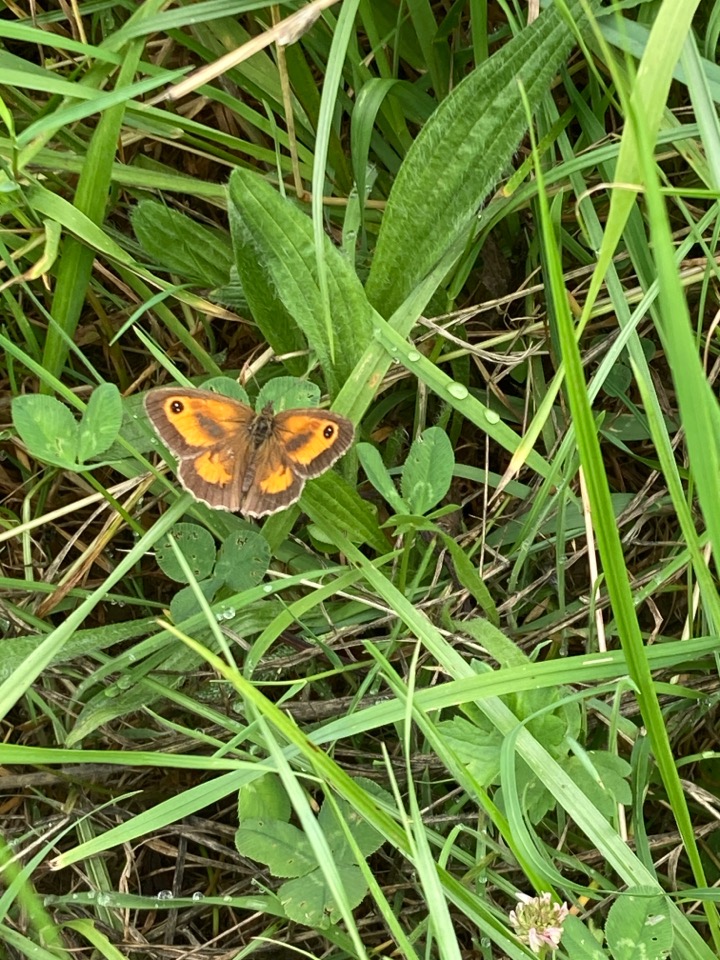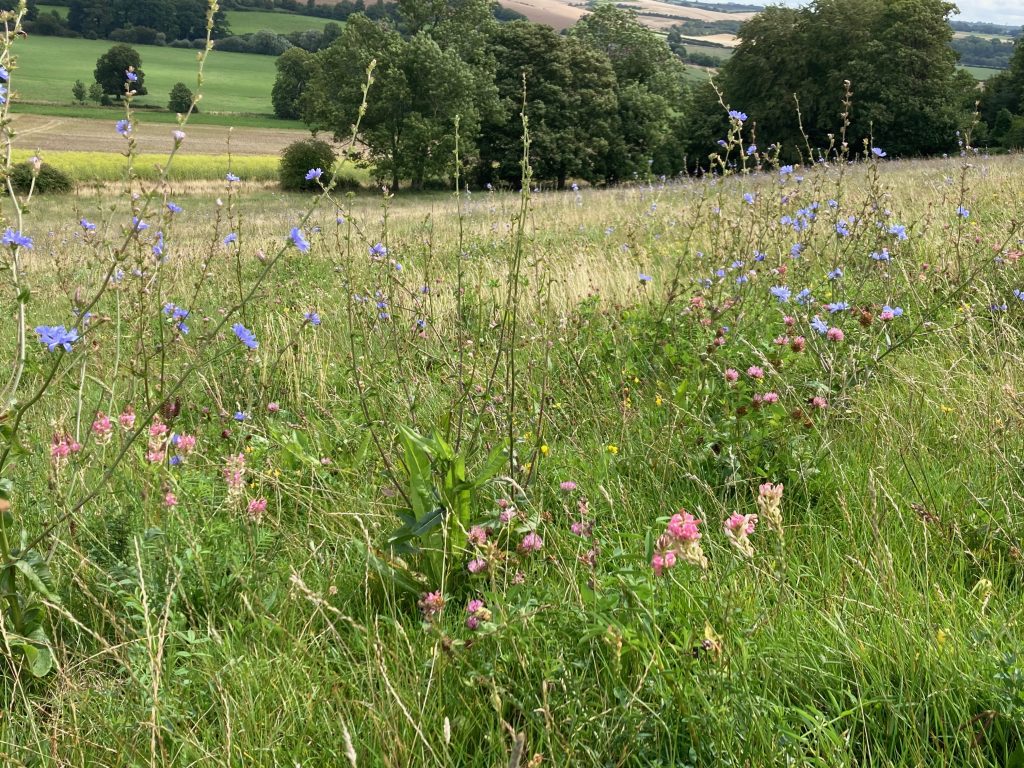The View from the hill 30th July 2023

Grasshopper – long word – short antennae
Cricket – short word – long antennae
Katydid – odd word – also known as a bush cricket – confusing the issue.
It’s a Meadow Grasshopper on the thumb, and a long winged meadow Katydid on the forefinger belonging to Penny the teacher who brought a class from Durweston to the farm at the beginning of July. That’s what the ‘Picture Insect’ app tells me at least. A proper student of wildlife would cross-check in learned books. However the app is good enough for me, life is too short to be buried in reference books. Apps like this one, the ‘Merlin bird song app’, and ‘Picture This’ for plants and trees have revolutionised my life, and have increased my screen time and shortened phone battery life alarmingly.

It was a lovely sunny day for this particular school visit, we had great fun looking at crops approaching harvest, wild flowers on chalk downland, and spent ages catching (mostly) grasshoppers, and quite a few other mini beasts. A sunny day in July is perfect for crawling about on hands and knees trying to catch insects for identification, and for learning new plants.

After that it was time to pull on the rubber gloves and find a cowpat suitable for excavation, not too old, not too fresh either, as Goldilocks said, it needs to be just right. Covered in holes on the surface, and firm enough to be a little crusty, but still soft enough inside to be populated with a variety of insect life, hopefully including dung beetles. If we do not dose our animals with wormers like those based on the very potent insecticide ivermectin, then there will be a better chance of dung beetle presence, they are an indicator of, and contributor towards, soil health, carrying dung deep into the soil profile with their burrowing activity. On this occasion we found a couple of beetles, who rapidly try to burrow away from daylight, numerous small unidentifiable flies, and this juicy character, a mealworm from another beetle species. A burrowing bird not worried about getting its beak dirty would be very pleased to find this.



Harvest has been pushing on when the weather has given us a chance. Here we were a week ago or more, having a nibble at the wildfarmed winter wheat, (reduced input), which has ripened earlier than the other wheats, however it wasn’t quite ready, so we then moved on to the spring barley, which is equally weather sensitive. Once milling wheat or malting barley is properly ripe, it is important to gather it swiftly, before the weather breaks and essential quality levels deteriorate. (Hagberg falling number in wheat, and germination in the barley). We also try to keep one eye on the straw, so that our long suffering straw contractor stands a chance of baling the straw before it gets soaked. If it looks like rain is imminent it’s a bit unfair to race through damp crop with the combine leaving line after line of soaking straw. This will only delay our return to the field to sow the next crop, so usually it pays to be patient. Baler right behind the combine on a sunny day with dust flying is the best of all, fields cleared super quick, and now that we have moisture, the oilseed rape or cover crops which will be sown as soon as possible afterwards, have a greater chance of swift emergence, and growing away while the sun is still high in the sky, every week’s delay in sowing reduces sunshine hours available for growth before winter.
At the end of July we have cut the winter barley and the oilseed rape, the early sown spring barleys, and the wildfarmed winter wheat. In all cases the heaps in the shed are sadly rather smaller than we had hoped for. We are still debating why this is, the usual suspect is the weather, and no different this year. A wet and cold winter, late cool spring and a boiling hot June have conspired to depress yield prospects. We have yet to discover what the main wheat crop has in store, where once again we have been experimenting with fertiliser and spray inputs.

We have sown a selection of crops in one field, to save the seed from to sow as over-wintering cover crops. This will be the third year we have done so, it is amazing how well the combine copes with such variation (and possibly something to do with the operator), the seeds are very different to our other crops, and the straw variable in texture and quantity, yet we have ended up with some usable samples. Some of them won’t be cut until after they will need to have been sown, so we will dry and store them until next year. The turnips we have already cut and cleaned with our ancient Rutherford cleaner, ready to sow again soon.


It was always going to be a hot day on 20th of July, we had been booked to attend Graduation day at Reading Uni for many weeks, and sure enough we were busy harvesting at home. Fortunately Fred stepped in and underwent a crash course in running the grain store, luckily not much needed drying that day, and it all went smoothly. The university laid on a pretty smart ceremony, with students all decked out in gowns and mortar boards, the Chancellor greeted every graduand with a few solemn words and a doff of his headgear, and bingo, we are the proud parents of another graduate in the family. The ceremony guide lists all the students graduating that day, and apparently this goes on for a whole week. Noticeable on our day was that as well as the agricultural sciences, architecture, politics with international relations, and consumer behaviour with marketing were also on the menu. I find it a little odd that there were twice as many students of consumer behaviour and marketing than there were of agriculture. There were about the same number of architects as agrics.
This in some small way could reflect the reducing numbers of people occupied in grass roots food production across the world. Technological advances, and the relentless drive to reduce the cost of food drives people out of the industry, and makes it ever more dependent on chemicals and fertilisers applied in text book fashion across vast areas, which cannot possibly be managed in a way that can produce food and at the same time preserve or improve soil health and protect environmental diversity.

In order to compete in a cut-throat world driven by the retailers and cost conscious consumers, (where no-one is prepared to pay the environmental cost of intensive farming), farming has become hugely competitive itself, arable farmers have long been paying silly money for rented or contracted land, and to cover all this land they need hugely expensive machines. Once committed to this capital expenditure and often unsustainable rent levels, the last thing they can risk is losing yield, so every avenue is followed to optimise production. This is very expensive, but in many cases farmers are often over-applying inputs because they can’t risk what they see as failure.
In our own case, we have achieved 11 tons per ha of wheat in four years out of the last ten, the first time in 2014. That for us is amazing, but we would be fools to think we can do that every year, the weather makes sure of that, rainfall and sunshine distribution will always have more influence than the fert and chems. Should we stick to the high input policy of those good years, implying that in the other six years we over-applied fert and chem, or should we settle for a bit less yield in the best years, and better match our input levels to the average output we might expect ? Paying close attention to the financial margins of different levels of input and output, and weathering the vagaries of international markets for grain and gas (fertiliser) is of course essential.
Along the way we are learning about the damage that chemical fertiliser does to the soil, it destroys organic matter and soil health in general, and are the fungicides we use to keep disease at bay on the plants above ground actually destroying the mycorrhizal fungi within the soil that are so important for healthy plant/soil interaction ? If we are to be serious about global temperature and human effect on the planet’s ecosystems, we really do need to address these issues.










Very interested in the compost maker and if anyone can tell me how to keep my cider apples on the tree in 60mph winds.
Hmmm. I feel the term lab is at odds with your ethos of working with nature in the production of food and distances children from their home experience. I think you have to use the word kitchen – it is what the children will have at home. What many in you area will have in reality is a Tesco kitchen. So why not twist that and call your room ‘Home Grown Kitchen’?
Over the year your notes on farming have increasingly incorporated the threads of nature until the moment when they become the same. That is an advance toward the ultimate wisdom
I can hardly believe that you haven’t moaned about the weather, it has made things a little awkward in East Anglia at least.
Where would you be with offering lower rents when land comes up then?
Farming a diminishing acreage with aging and less shiny machinery perhaps?
Great idea that kitchen though but I wonder how long home grown food will be available.
With the new Sustainable Farming Initiative it seems that food production by English farmers (other countries in the UK have different ideas) is no longer necessary anyway.
Perhaps some grasshopper meals?
Sorry been a long wet day here again.
Interesting at every new topic George. I loved your take on the cost of high yields and realistic goals. Also good to see the cover crop work is continuing to be manageable and accompanied by wonderful photos. Thanks George and congrats on you latest graduate.
Ali in NZ.
Interesting at every new topic George. I loved your take on the cost of high yields and realistic goals. Also good to see the cover crop work is continuing to be manageable and accompanied by wonderful photos. Thanks George and congrats on you latest graduate.
Ali in NZ.
Great to hear about the kitchen. Suggest : Shepherds Corner Kitchen ,
Shepherd Corner Counter,
Home Grown Corner.
Another wonderfully informative edition George – so much to learn from sensible, sustainable and seasoned practitioners.
Agree with Loyal Reader about not using ‘lab’ – too many chemical connotations. Perhaps just ‘Farm Food Room’ or ‘Farm Food Kitchen’? Look forward to seeing it grow!
A fascinating and informative read for a non-farmer. What a lot of variables to juggle, enough to make your head spin…I think I’ll stick to teaching!
How about calling your kitchen classroom project ‘Food for thought’?!
Another great read, thank you George!
Simon
Another informative read. Looking forward to seeing the completed ‘Cultivate & Cook Corner’ or whatever it ends up being named!
George, another cracker and I have recommended the blog to the (ancient) cohort who left Wye in the 1970s and have their own quite active Whatapp group. Hopefully a few might also sign up. You REALLY need to be widely read – and not just by farmers. Have you thought about adding your style of journalism to your activities?
Hi George, we were contemporaries at Wye back in 79-81. I came across your blog by chance – I am not involved in growing but have worked in conservation and currently volunteer. The term Katydid is American, we tend to call them (i.e.
Tettigoniidae) Bush Crickets. Unless that is a captive specimen of an American species, it is probably a Short-winged Conehead (Conocephalis dorsalis).
It is very interesting to read your reports from the field and to hear how you are trying to incorporate more eco-friendly approaches. I’d like to second what Chris IJ said. An informed and enterprising voice such as yours deserves to be heard more widely! The issues you deal with are key to the future of farming and the world more generally. We tend to be increasingly polarised and you could represent a useful bridge across the divide.